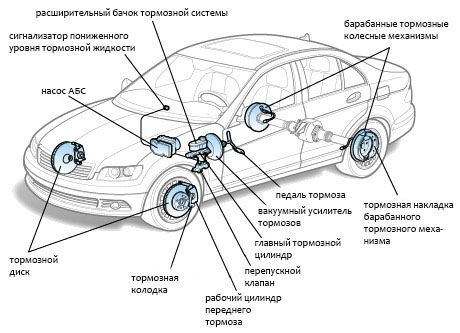
How to replace the anti-lock brake fluid level sensor on most modern cars
The Anti-Lock Brake System (ABS) has a fluid level sensor that fails when the warning light comes on or if the fluid reservoir is low.
Most modern cars are equipped with an anti-lock braking system (ABS). The Anti-Lock Braking System is a modern safety feature that significantly improves braking performance, especially in adverse conditions. It is designed in such a way that the driver does not need much effort to achieve the maximum braking potential.
The function of an anti-lock braking system is to allow the braking system to operate at its maximum potential for a given system, and it does this by modulating brake pressure so that the wheels do not lock up under heavy braking. .
The anti-lock braking system is especially useful when braking very hard to avoid an accident when the roadway is wet from rain, covered in snow, icy or driving on loose road surfaces such as mud or gravel.
The system intuitively, through a combination of sensors, electric servos/motors and control units, can detect wheel lockup and correct brake pressure in a fraction of a second. The anti-lock braking system is designed to detect wheel lockup, release enough pressure to get the wheel to turn again, and maintain the brake system's maximum possible pressure without the driver having to manually make any further adjustments.
When there is a problem with the anti-lock braking system (ABS), it is common for a red or yellow warning light on the instrument cluster to alert the driver that there is a problem in the system. There are several problems that can cause the warning light to come on. If the sensor fails, you may experience wheel lockup or notice that the reservoir is low on fluid.
The ABS brake fluid level sensor monitors the brake fluid level in the reservoir to inform the driver if the level drops below the minimum safe level in the event of a malfunction. The level will usually fall below safe levels in the event of a leak or when the brake system components are sufficiently worn. The following article will cover the replacement of a standard anti-lock brake fluid level sensor in a manner applicable to most common modern vehicles.
- A warning: Be aware that when working with brake fluid, it is very corrosive on any painted/finished surface and can damage these surfaces if they come into contact with each other. Brake fluid is water soluble in most standard brake fluid types and can be easily neutralized with water. In the event of a spill, quickly flush the affected area with water, being careful not to contaminate the brake fluid still in the system.
Part 1 of 1: Replacing the ABS Brake Fluid Level Sensor
Necessary materials
- Assortment of pliers
- Screwdrivers
- Towel/cloth shop
- Set of wrenches
Step 1: Locate the ABS brake fluid level sensor.. Locate the ABS brake fluid level sensor on the brake fluid reservoir.
There will be an electrical connector that plugs into it that sends a signal to the computer and turns on a warning light on the dash when there is a problem.
Step 2. Disconnect the anti-lock brake fluid level sensor electrical connector.. Disconnect the electrical connector coming from the ABS brake fluid level sensor.
This can ideally be done by hand, but as the connector is exposed to the elements, the connector can freeze over time. You may need to gently push and pull on the connector while holding the latch. If it still won't release, you may need to carefully pry the connector off with a small screwdriver while holding the latch.
Step 3. Remove the anti-lock brake fluid level sensor.. At the opposite end of the sensor from the electrical connector, squeeze the end of the sensor with pliers.
Do this by gently pulling on the end of the connector. This should allow the sensor to slide out of the recess it is in.
Step 4: Compare the removed anti-lock brake fluid level sensor with the replacement. Visually compare the replaced brake fluid level sensor with the removed one.
Make sure the electrical connector is the same, the same length, and that it has the same physical dimensions as the remote.
Step 5 Install the replacement ABS brake fluid level sensor.. The replacement anti-lock brake fluid level sensor should fit into place without much effort.
It should only go in one direction, so if there's abnormal resistance, make sure it's in the same orientation as the old one that came out.
Step 6 Replace the electrical connector.. Push the electrical connector back into the brake fluid level sensor until the locking tab clicks into place.
A click should be heard, or at least a perceptible click, when the locking tab engages.
Step 7: Confirm the installation of the replacement ABS brake fluid level sensor.. Start the vehicle and check that the warning light on the instrument panel is off.
If the light is still on, be sure to check the fluid level in the reservoir. If the light stays on, there may be another problem and you need to fix it.
The anti-lock braking system of a modern car is one of the most important systems in a car. Most other systems can operate even in sub-optimal condition, but the braking system must be in good working order for the safety of not only the driver, but everyone around. If at some point you feel that it will not hurt you to replace the brake fluid level sensor of the anti-lock braking system, contact one of the certified AvtoTachki specialists.